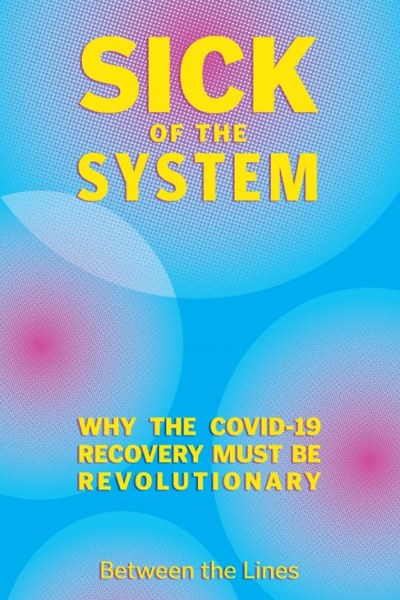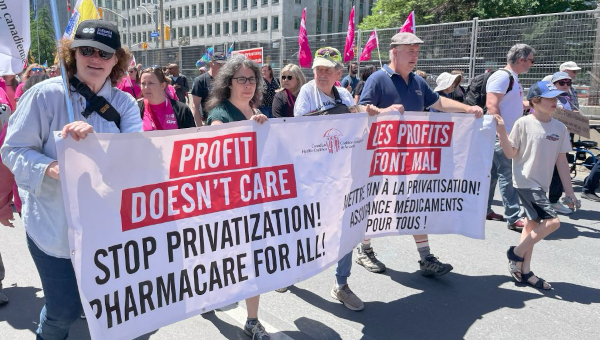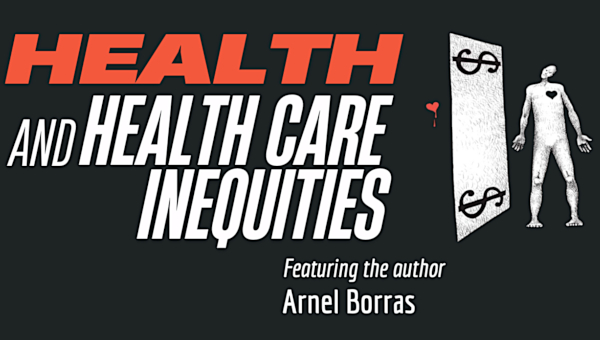Novel Virus, Old Story: Government Failings Put Healthcare Workers at Risk
An Ontario nurse with COVID-19 is terrified she will infect her young child. A COVID-19 screener in a small urban hospital isn’t provided with personal protective equipment (PPE) as she undertakes nasopharyngeal swabbing of suspected cases. A personal support worker (PSW) in a long-term care (LTC) facility sits in her car in tears before starting her shift, knowing that neither she nor the residents she cares for are being adequately protected.

The health crisis unfolding around the globe with the arrival of the novel coronavirus, COVID-19, has already had monumental impacts. News media report the pandemic is an unprecedented event. However, casting this crisis as exceptional narrows the focus. While the COVID-19 virus is unprecedented in its transmissibility, the lack of preparedness and inadequate protection for healthcare workers (HCWs) is an old story. If we look through the lens of worker protection, the COVID-19 pandemic is neither novel nor unforeseen. In many ways, it is an escalation of the ongoing failure of health and safety regulatory oversight. It also underscores the chronic underfunding and increasing privatization of the healthcare sector. These problems are aptly illustrated in Ontario, where bed shortages, wait times, and understaffing plague the system. The Canadian Centre for Policy Alternatives reported in 2019 that Ontario – tied for last place with Mexico – had fewer hospital beds per capita than any of the OECD countries.
The International Council of Nurses reports thousands of nurses, doctors, and other HCWs have been infected in the course of their work, and some have died. Exposed HCWs of all ages and conditions are at risk. When viewed through the experiences of those on the front lines, the coronavirus response has been a series of failures: failure to apply the precautionary principle, which is fundamental to public health, failure to provide proper protections for workers, failure to implement recommendations to improve worker health and safety, and failure to place human health before the economy. The lessons of the past are crucial to understanding what is happening now.
Precautionary Principle Ignored
The date of symptom onset for the first case of COVID-19 in Canada was January 15, 2020, in Toronto. However, governments did not take significant control measures until weeks later. The COVID-19 pandemic has shifted the landscape of healthcare in Canada and across the globe. HCWs – including nurses, screeners, doctors, PSWs, environmental personnel, and others on the front lines – are at particular risk of infection, especially given the lack of adequate PPE.
Government officials should have abided by the precautionary principle, which states, “When an activity raises threats of harm to human health or the environment, precautionary measures should be taken even if some cause and effect relationships are not fully established scientifically.” Instead, governments waited to act until there was evidence that COVID-19 was spreading. Governments at all levels, in a co-ordinated strategy, should have been mobilizing earlier for greater protections.
Uncertainties about Transmission Undermine PPE Provision
There is a global shortage of PPE, especially medical N95 respirators, designed to provide better protection than surgical masks (also in short supply). The PPE shortage is influencing policy. The burning unanswered question is how the virus is so readily transmitted. It has been established that it can be carried in droplets – large or small. Aerosolizing procedures, such as intubation, can release tiny infected droplets into the air. Public Health Ontario guidelines require that N95 masks, face shields, gowns, and gloves be used by HCWs during such procedures.
A troublesome and ongoing debate that has a direct impact on HCWs is whether or not COVID-19 can be transmitted through “airborne” particles or become “aerosolized” simply through coughing, sneezing, or even just breathing. Studies publicized in the early spring of 2020 provide growing evidence that COVID-19 can become airborne. But many health officials, including those making decisions about worker protection in the province of Ontario, continue to contend that the pathogen is only transmitted through droplets and contact.
HCWs have also been assured that maintaining a distance of six feet is protection enough. Yet, research has determined that coughing and sneezing can transmit droplets several metres. Numerous studies conclude that COVID-19 can be spread before it causes symptoms; in other words, coughing and sneezing do not have to be present for the virus to be transmitted. Breathing alone might spread the virus. Recommendations based on several studies showing increasing evidence of airborne transmissibility of COVID-19 are that HCWs be provided with respirators, such as N95s, or superior cartridge-filter or powered air-purifying respirators (PAPRs). Until early March 2020, the US Centers for Disease Control and Prevention (CDC) recommended that all HCWs potentially coming into contact with COVID-19 patients be provided with an N95. The agency changed its guidelines and now recommends only surgical masks for non-aerosolizing care.
Similarly, the California Occupational Safety and Health Administration (Cal/OSHA) issued guidelines for the use of N95s for all HCWs. Cal/OSHA warned: “Surgical and other non-respirator face masks do not protect persons from airborne infectious disease and cannot be relied upon for novel pathogens. They do not prevent inhalation of virus particles because they do not seal to the person’s face and are not tested to the filtration efficiencies of respirators. Surgical and face masks must not be used instead of an approved respirator such as an N95 mask.” On March 28, 2020, Cal/OSHA weakened its guidelines due to shortages.
These compromises with PPE are based on the availability of supplies, rather than science. Lisa Brosseau, a University of Illinois expert on respiratory protection for infectious disease, wrote on March 16 for the Center for Infectious Disease Research and Policy about the limitations of surgical masks. Her commentary said that, in light of recent scientific findings, “healthcare organizations must return to using respirators for confirmed and suspected COVID-19 patients when supply chain problems are resolved.”
Healthcare Staff Afraid and Abandoned
Through March and early April 2020, the Ontario Council of Hospital Unions/Canadian Union of Public Employees (OCHU/CUPE) staff and representatives have received hundreds of calls, emails, and direct inquiries from HCWs represented by the union. HCWs are seeking direction and support regarding concerns and frustrations over what they perceive is inadequate protection for themselves and their colleagues.
The union polled its members and found that of the 3,000 respondents, 87 per cent reported they do not have access to the PPE they need to deal with COVID-19 patients, and 91 per cent said they feel abandoned by the provincial government. Members are wondering how they will cope with the risks, both as community members and as family members, knowing they may potentially be virus transmitters.
HCWs are facing considerable obstacles to achieving adequate protections. Michael Hurley, president of OCHU, told the Kingston Whig-Standard on April 7, “There’s a fear and desperation and a fair bit of anxiety and a feeling of abandonment…. We’re told equipment is coming, but it never really arrives.” It is not just immediate fear and anxieties that HCWs are facing. They will likely also experience longer-term PTSD and mental health impacts from their working conditions.
SARS Commission
We have been here before – the SARS outbreak of 2003 provided a roadmap for dealing with future outbreaks. A royal commission was established that held hearings to explore what was done right and what was handled wrong. The response to the COVID-19 virus by governments, public health agencies, businesses, and institutions would have been better handled had the precautionary principle recommendation of the SARS commission been followed.
In its 2006 report, the SARS Commission recommended that all workplace parties be involved in planning for future outbreaks, including being prepared with adequate supplies and capacities. It emphasized the importance of “listening to front-line health workers.” It recommended that “in any future infectious disease crisis, directives involving worker safety be prepared with input from the workplace parties who have to implement them, including employers, health worker representatives and Joint Health and Safety Committees.”
The expert knowledge of those with direct first-hand experience, as recommended by the commission, is essential. This is especially true now, as HCWs contend with potentially increased risks due to shortages of PPE. Their ideas for administrative or engineering controls to limit contact, as well as judicious use of available PPE, may be of particular value.
Failure to Follow Recommendations
The SARS Commission also stated that N95s would provide the needed level of respiratory protection for HCWs during a viral outbreak, and that they should be available at all times in sufficient quantities. The Toronto Star reported that Ontario followed the recommendation to purchase and store N95s and other medical supplies. Although fifty-five million N95s were purchased, after their expiry dates were reached, the government disposed of most of them in 2013 and failed to replace them. Indeed, our federal and provincial ministries of health largely failed to heed the recommendations not only of the SARS Commission, but also of reports published in 2006, 2008, 2010, 2018, and 2019 on the inadequacies of outbreak preparedness.
Dr. Sandy Buchman, president of the Canadian Medical Association, told the Globe and Mail on April 9, 2020, that governments were caught “flat-footed.” He referred to the 2006 government-sponsored report that harshly warned that Canada needed to be better equipped for serious outbreaks. Hospitals were warned to prepare by increasing their capacity to deal with an influx of patients. Protective equipment for HCWs was to be made available in sufficient quantities. Nevertheless, he said, “all we have seen are cutbacks. We haven’t seen adequate resources allocated to health care.”
The Roots of Current Inadequate Protections
The inadequacies in the Canadian healthcare system are not new, nor are they strictly related to the added strains caused by the current COVID-19 pandemic; the problems go deeper. The system has been operating under capacity for a long time.
A significant moment in the erosion of the healthcare system was the 1995 decision by federal finance minister Paul Martin to introduce the Canada Health and Social Transfer legislation, which significantly reduced federal transfer payments to the provinces. The result was substantial increases in private, for-profit corporate involvement and a transformation of the organization of work within healthcare facilities as pressure mounted to reduce expenditures.
In 2002 the Royal Commission on the Future of Health Care in Canada, chaired by Roy Romanow, was established to “improve the system and its long-term sustainability.” The commission’s recommendations for short- and long-term investments and greater accountability were largely ignored as provincial governments encouraged greater for-profit corporate involvement in the hope of reducing their costs.
The current lack of testing capacity for COVID-19 cases can be traced to deep cuts to laboratory budgets, which have suffered under privatization. Emergency room and admitting wait times have been growing, and staffing is profoundly inadequate. According to a 2016 report from CUPE, there were almost 20 per cent fewer hospital nurses in Ontario compared to the rest of Canada. In real numbers, this means that “Ontario is missing 15,200 [nurses] in our hospitals compared to the amount of hospital nursing care in the rest of Canada.”
Many HCWs, especially those employed in LTC, are working part-time or in multiple sites – often in precarious positions. A 2017 report by the US-based Commonwealth Fund, an independent organization that ranks the healthcare systems of eleven countries each year, places Canada near the bottom of the list. It uses many indicators in its evaluation, such as access to medical care, wait times, infant mortality, and the number of medical errors. Now, the healthcare system is dealing with a global pandemic of an unprecedented scale, and it is egregiously ill equipped.
HCWs in the bare-bones Ontario healthcare system are also suffering in terms of workplace safety from the neoliberal austerity strategies of the Mike Harris government in the 1990s. The regulatory system has never recovered from the diminished capacity and roles of the Ministry of Labour inspectors, hygienists, and other occupational health and safety specialists.
Individual Responsibility under Neoliberalism Obscures Systemic Risks
COVID-19 is bringing out the many flaws in our healthcare system, our public health approaches, and the dogma of neoliberal capitalism. Neoliberal ideas value a smaller welfare state, where governments do less, and individuals and families are responsible for their own well-being; the commodification of social goods including health care and education; and economic efficiency enabling an unfettered “free market.” The neoliberal system’s ideology of individual responsibility contributes to and exacerbates inequalities and injustices.
The ideas of individual choice and responsibility dominate neoliberal arguments and health policies. By focusing on individually modifiable personal behaviours, neoliberal ideas omit primary prevention of systemic risks and structurally influenced factors through regulation, policy, economic decisions, and cultural values. Behavioural actions recommended by health authorities as protective for COVID-19 include physical distancing, frequent hand washing, and staying home when sick. These individual-level strategies are important for slowing the spread of COVID-19; however, they are insufficient from a systems perspective, as they fail to capture that health exists in a nested set of relationships. Individual health is the sum of the conditions of families, workplaces, communities, nations, and even global conditions.
For HCWs, individualizing their risks separates them from the broader healthcare system they are working in, and from the ways neoliberal values have eroded the protections that are necessary for them to carry out their work safely.
Moving Forward through Systemic Solutions
Governments across the globe, and currently in Ontario, failed to implement systemic protections and policies with regard to the COVID-19 pandemic in a timely fashion, especially where they impacted HCWs. If they had been systematically abiding by the precautionary principle, governments would more likely have foreseen the vulnerabilities in our systems. They could have taken definitive measures to mitigate risks.
Scientific, public health, and systems knowledge are all needed as we respond to COVID-19. At a fundamental level, maintaining a fully publicly funded healthcare system would have been better and safer. Further, applying the recommendations of the multiple reports and commissions that examined past health crises would also have prepared the healthcare system to better respond to the current needs for HCW protection. When the signs were there that the virus was becoming a serious public health threat, actions could have been taken to prepare the system to deal with the need for increased HCW safety measures.
The COVID-19 healthcare crisis provokes a number of questions. What will the world look like after the pandemic? Will we be better prepared for the next one? Will HCWs be better protected? Will there be a reinvestment to remedy the weakened public healthcare systems? Are there lessons for broader precautionary measures for other critical health threats, such as climate change?
We need a systems approach that sees beyond the individual to the collective nature of how we live, work, and play. A revamping of priorities – away from the profit motive and toward the health and well-being of persons – mandates investment in preparations that would mitigate risks and improve the lives of everyone. •
This essay first published in Sick of the System, Between the Lines, 2020.






